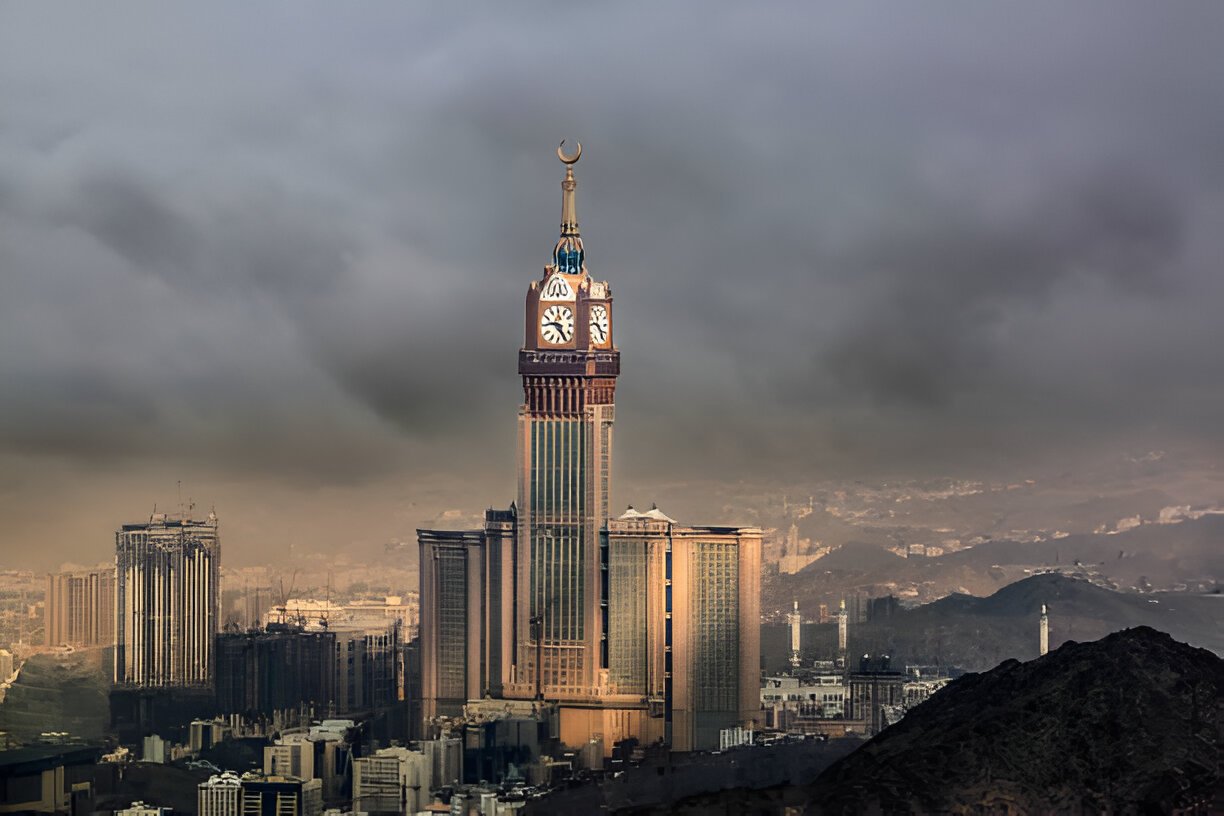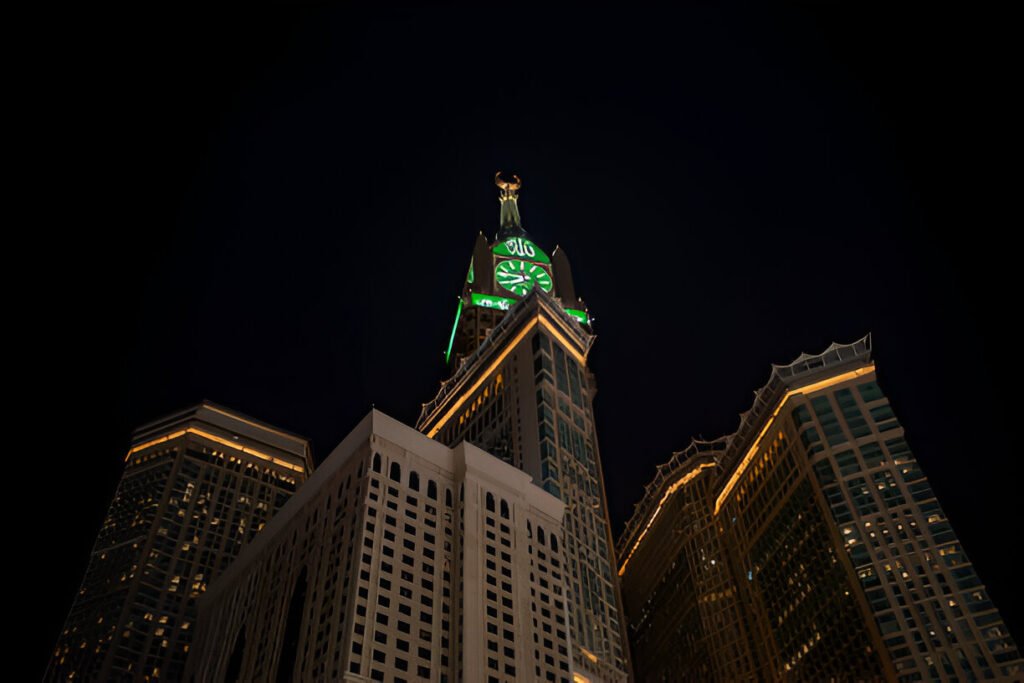The Wonders of the World Makkah Royal Clock Tower
The Makkah Royal Clock Tower is one of the most talked-about and beautiful buildings in the world right now. This tower is a stunning example of architecture and is situated in the holy city of Makkah, close to the southern entrance of Masjid al-Haram, the most revered mosque in Islam. One of the most striking structures in the world, the Makkah Clock Tower attracts particular attention from pious Muslims traveling for the Hajj and Umrah because of its magnificence, beauty, and elegance.
Construction Process of the Clock Tower
The tower’s construction was finished in 2011, having started in 2004. It was formally opened in 2012. The tower, which cost $800 million to build, can hold 10,000 people for prayer. Visitors can learn all about the clock’s details and workings by purchasing a ticket.
By monitoring the clock movements from a distance, people who are deaf or mute can comprehend prayer times thanks to the clock’s design. The clock changes from black and white during the day to white and green at night to improve visibility. Muslims who go from all over the world describe how happy they are to see this remarkable clock.
Height of the Clock Tower
The time on the clock can be seen from a distance of 17 kilometers. The installation of the 36,000-ton clock took eight years and was overseen by 250 experts from nations including Germany and Switzerland. The clock’s uppermost section weighs 12,000 tons. The clock, which is 601 meters above the ground, is visible at night from a distance of 30 kilometers.
The tower has 3,000 rooms with modern amenities for pilgrims performing the Hajj and Umrah, as well as a museum and a moon observation facility. A 93-meter-tall spire, embellished with golden mosaics and a 35-ton fiberglass crescent, stands at the summit of the clock. The call to prayer can be heard up to seven kilometers away thanks to the thoughtful placement of high-power loudspeakers from the tower’s base to its summit.
Abraj Al-Bait
Adjacent to the revered Masjid al-Haram, the Abraj Al-Bait Complex is made up of seven tall towers. The Saudi government owns this complex, which includes the Makkah Royal Clock Tower. Saudi Arabia’s founder, King Abdulaziz, had the idea to modernize Makkah in order to make the Hajj pilgrimage easier, and this project was his idea.
The Makkah Royal Clock Tower, the third-highest structure in the world and the tallest clock tower in the world, is the center tower among the seven. When combined with adjacent buildings, it ranks as the world’s sixth-highest landmark.
The complex was built after demolishing the famous Ajyad Fortress, an 18th-century Ottoman architectural landmark that once stood on a hill overlooking Makkah. The demolition of the fortress in 2002 for this project drew international criticism, with Turkey being particularly vocal in its opposition.
Uniqueness of the Complex
With a height of 601 meters (1,972 ft), the highest tower in the complex is also the tallest structure in Saudi Arabia. It is shorter than the Burj Khalifa in Dubai, the Tokyo Skytree in Japan, the Shanghai Tower in China, and the Canton Tower in Guangzhou, but it is taller than the Ping An Finance Center in Shenzhen, China. South of the Abdulaziz Gate, Masjid al-Haram’s main entrance, the tower overlooks the Piazza. The Kaaba, the holiest place in Islam, is located inside Masjid al-Haram.
Ten thousand worshippers can be accommodated in the two spacious prayer halls of the Abraj Al-Bait towers, one for men and one for women. A five-star hotel run by Fairmont Hotels & Resorts, which accommodates some of the yearly Hajj pilgrims, is housed in the highest structure.
In addition, the property has a parking lot that can accommodate thousands of cars and the Abraj Al-Bait Shopping Mall, a five-story shopping center.
At first, the highest tower was supposed to be 734 meters (2,408 feet) high, but it ended up being 601 meters. Premier composite technology was used to construct the uppermost section, which was created by German architect Mahmoud Bodo Rasch and his team. This section includes a massive clock made by Perrot GmbH & Co., a German business. The complex was built at a cost of more than $15 billion, according to the Saudi Ministry of Religious Affairs.
The clock may be viewed from anywhere in the area because it is viewable from every side of the main hotel tower. Inside the tower, residents reside up to 1,210 feet above the ground. The clock itself is the biggest clock in the world, standing 141 feet tall and 141 feet wide. Standing at 450 meters above the ground, the clock is higher than others, rising to 601 meters with its spire included. Along with hosting astronomy exhibits, this section keeps an eye on the moon during important Islamic holidays and months. This area also has an automated clock management system.
 Features of the Towers
Features of the Towers
The four enormous clocks that round the main tower are the largest clocks in the world by area, and they can be seen from as far away as 25 kilometers. The Cevahir Mall in Istanbul, Turkey, used to have the biggest clock by area. Around two million LED lights illuminate each of the 141-foot-diameter clock faces at the Abraj Al-Bait Complex.
The Arabic word “Allahu Akbar” (God is Great) is written above the northern clock face. The Kalima Tayyiba, which reads, “There is no god but Allah; Muhammad is His Messenger,” is shown on the other three clocks in Arabic. The clock faces are encircled by four golden domes, and their design incorporates green and white lighting to match the Saudi flag’s colors.
The tower has 16 bands of vertical light beams that extend up to 10 kilometers into the sky on important occasions like New Year’s. A golden sign of two crossed swords, representing Saudi Arabia, is positioned in the center of the clocks, which are embellished with 98 million pieces of glass mosaic. Each clock’s hour hand is 56 feet long, and its minute hand is almost 75 feet long.
The tower’s 1,831-foot and 1,290-foot observation decks are accessible to visitors. The clocks were originally intended to show Makkah’s local time, but they were ultimately adjusted to Arabian Standard Time.
A research center and exhibition are housed in a thin, eight-story golden minaret at the summit of the tower. At the top is a fiberglass crescent with a gold mosaic that weighs roughly 35 tons. In 2011, Premier Composite Technologies produced the crescent in Dubai. Hundreds of laborers and five engineers worked on the project, which took three months to finish and cost 90 million Emirati dirhams. Before being placed on July 6, 2011, the crescent was delivered in ten sections and put together on location.
The call to prayer can be heard from seven kilometers afar thanks to the loudspeakers installed in the minaret. This part projects sixteen beams of light into the sky on the beginning day of the Hijri year and on the two Eids.
The green and white lights on the clock were designed for deaf individuals in Makkah and surrounding areas, enabling them to recognize prayer times visually.
Construction Accidents
At least two fire accidents happened when the Abraj Al-Bait Complex was being built. The first occurred at the Hajar Tower on October 28, 2008, and it took 400 firefighters ten hours to put out the fire. The widespread use of wood in construction, according to witnesses, caused the fire to spread quickly. Soon, smoke filled the entire tower. Luckily, there were no recorded casualties. On May 1, 2009, a second fire broke out at the Safa Tower; however, no one was hurt.
The complex was controversial when it was built, especially after the Ottoman Ajyad Fortress from the 18th century was demolished. However, a number of historic buildings will have to be demolished as part of Saudi Arabia’s efforts to upgrade Makkah into a fully developed metropolis.
By 2040, the Saudi government aims to expand the capacity of prayer spaces from 3 million to 7 million worshippers. “Visitors often prefer staying close to the Clock Tower for convenience. Find the best hotel prices here.”



